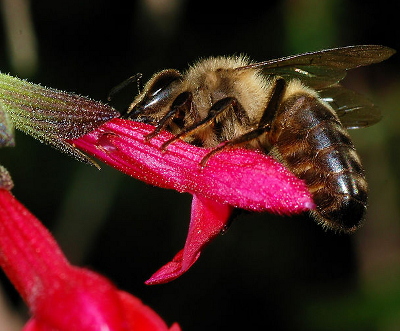
A history of honeybee varieties in America
 The final thread I enjoyed untangling from Horn's Bees in America
was the history about which types of honeybees were being raised in
American apiaries over the last few centuries. Horn reported that
the first bees to be brought to what would later become the United
States were German black bees. These scrappy bees quickly swarmed
into the wild and spread west ahead of the settlers, although they
needed help crossing the Great Plains.
The final thread I enjoyed untangling from Horn's Bees in America
was the history about which types of honeybees were being raised in
American apiaries over the last few centuries. Horn reported that
the first bees to be brought to what would later become the United
States were German black bees. These scrappy bees quickly swarmed
into the wild and spread west ahead of the settlers, although they
needed help crossing the Great Plains.
German black bees
continued to be the primary variety until the same Langstroth who
developed the Langstroth hive was involved in introducing Italian bees
to America. Throughout the second half of the nineteenth century,
many different kinds of bees were imported from abroad, but Italians
soon became the most popular due to their gentleness. However, a
federal law in 1922 outlawed further imports of foreign bees in an
effort to block out the Isle of Wight disease.
For a while, Americans seemed perfectly happy with what they had, but the pests and diseases
that kept cropping up in apiaries made some beekeepers itch to import
new varieties again. Horn reports that, while American bees have
largely been bred to similar genetics for the most efficient honey
production, Europe has a more artisanal approach to honeybees, with lots
of different varieties available for different purposes.
Especially after tracheal and varroa mites arrived in the U.S. in the
1980s, many American beekeepers realized that finding more resistant
bees was a better approach than dousing hives in chemicals, and in 2004,
the federal law against importing honeybees was overturned.
In
the meantime, nature was filling in the gap. Africanized
honeybees (popularly known as "killer bees") are survivors, able to find
nectar in a dearth, to
build up to swarm size quickly, and to defend the hive
aggressively.
The bees were introduced on purpose in Brazil in the 1950s, but they
quickly swarmed
north, resulting in many terrified efforts by the U.S. government to
prevent the influx of so-called killer bees. By the time the
variety reached the Texas border, though, we realized the problem wasn't
as severe as we'd imagined, although policies continue to isolate bees
along border counties to slow their spread. When Horn's book was
published, Africanized
honeybees were only found in California, Arizona, New Mexico, Nevada,
Oklahoma, Kansas, Texas, Puerto Rico, and the Virgin Islands since cold
and
humidity seem to be preventing the bees from spreading further north and
east.
As long-time readers will
know, we've had a lot of trouble keeping honeybees alive without
chemicals, and the only hive that has so far gone the distance is a colony of bees bred in Texas using some Africanized genetics.
Yes, our part-killer bees are a little meaner than any of the other
colonies we've had, but they also seem able to live without any
medications at all (so far). While that's a very small sample
size, it makes me wonder if we should be terrified of Africanized bees,
or if we should embrace the spread of honeybees that seem able to handle
modern problems with aplomb. I'd be curious to hear from others
who have dabbled in chemical-free beekeeping --- do you think a slightly
meaner hive is worth the tradeoff for simpler beekeeping?
| This post is part of our Bees in America lunchtime series.
Read all of the entries: |
Want more in-depth information? Browse through our books.
Or explore more posts by date or by subject.
About us: Anna Hess and Mark Hamilton spent over a decade living self-sufficiently in the mountains of Virginia before moving north to start over from scratch in the foothills of Ohio. They've experimented with permaculture, no-till gardening, trailersteading, home-based microbusinesses and much more, writing about their adventures in both blogs and books.
Want to be notified when new comments are posted on this page? Click on the RSS button after you add a comment to subscribe to the comment feed, or simply check the box beside "email replies to me" while writing your comment.
- Remove comment
